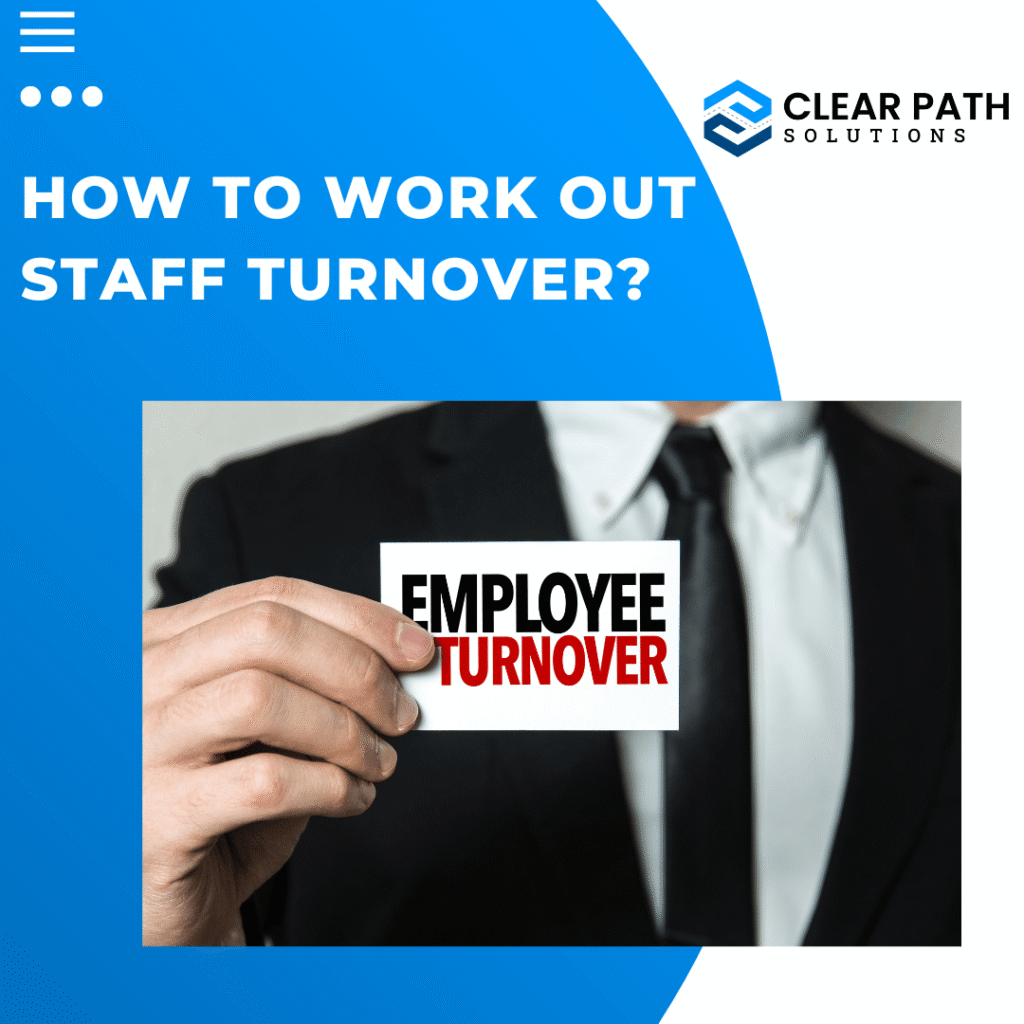Staff turnover is one of the most telling indicators of a company’s workplace culture, employee satisfaction, and operational stability. For all employers, keeping an eye on this metric is essential for making informed HR decisions, managing costs, and retaining top talent.
In this blog guide, we’ll comprehensively walk you through – what staff turnover is, how to calculate it, why it matters, and what you can do to improve it?
So, What Is Staff Turnover?
Staff turnover (or employee turnover) measures the rate at which employees leave your organisation within a specific period.
It includes all types of departures:
Voluntary turnover – when an employee resigns
Involuntary turnover – when an employee is dismissed, made redundant, or leaves due to organisational restructuring
While some turnover is inevitable (and even healthy), a consistently high rate can indicate deeper problems, such as poor job satisfaction, ineffective management, or inadequate recruitment processes.
Why Staff Turnover Matters to Employers?
For employers, tracking staff turnover isn’t just about numbers. It’s about business impact.
- Cost implications – High turnover increases recruitment, onboarding, and training costs.
- Productivity loss – New hires take time to reach full efficiency.
- Knowledge drain – Experienced staff leaving can take valuable expertise with them.
- Employer brand – High turnover can damage your company’s reputation, making it harder to attract talent.
- Workplace morale – Constant changes can lower motivation and team cohesion.
Ultimately, employee turnover rate is a critical factor impacting business stability, productivity, and costs. High turnover often signals underlying workplace issues, while low turnover reflects employee satisfaction, strong retention strategies, and organizational success.
How to Calculate Staff Turnover – The Formula
The most common formula for calculating staff turnover is:
Staff Turnover Rate (%) = (Number of leavers during a period ÷ Average number of employees during that period) × 100
Step-by-Step Scenario Example:
- Timeframe: 12 months (January – December)
- Number of leavers during the year: 15
- Number of employees at start of year: 80
- Number of employees at end of year: 100
Step 1 – Work out average number of employees:
(80 + 100) ÷ 2 = 90
Step 2 – Apply the formula:
(15 ÷ 90) × 100 = 16.67%
Result: Your annual staff turnover rate is 16.7%.
Voluntary vs. Involuntary Turnover – Why It Matters
Not all turnover is negative. Separating voluntary from involuntary turnover gives you deeper insight.
Voluntary turnover – Could indicate dissatisfaction, lack of career growth, or competitive offers elsewhere.
Involuntary turnover – Could result from performance issues, redundancies, or restructuring.
Example: If your voluntary turnover rate is 12% but industry benchmarks are around 8%, it may signal a retention problem.
How Often Should Employers Measure Turnover?
Employers should measure employee turnover regularly to gain timely insights into workforce stability and identify emerging retention issues. Frequent monitoring allows businesses to react quickly to rising attrition, adjust HR strategies, and implement retention initiatives before problems escalate. It also helps compare turnover against industry benchmarks and internal goals. By measuring turnover consistently, employers can evaluate the effectiveness of workplace policies, track improvements over time, and ensure a healthy, engaged workforce that supports long-term organizational growth and productivity.
Annually – To see long-term trends
Quarterly – To respond quickly to sudden spikes
Monthly – In high-churn industries like retail or hospitality
For most UK businesses, quarterly reviews strike a good balance between detail and efficiency.
Benchmarking Staff Turnover in the UK
Turnover rates vary widely between industries:
Hospitality & Retail – Often above 30% due to seasonal work
Healthcare – Around 15–20%
Professional Services – 10–15%
Public Sector – 8–12%
Comparing your figures to industry averages helps identify whether you have a genuine issue or are in line with normal patterns.
By benchmarking, organizations can identify whether their turnover is unusually high or within a healthy range. This comparison helps employers pinpoint underlying issues like poor engagement, lack of growth opportunities, or inadequate compensation. Using UK-specific benchmarks allows companies to set realistic targets, strengthen retention strategies, and remain competitive in attracting and keeping top talent.
Common Causes of High Staff Turnover
From an employer’s perspective, high turnover often stems from:
- Poor recruitment fit – Hiring candidates who don’t align with the role or company culture.
- Lack of career development – Limited progression opportunities.
- Inadequate pay or benefits – Competitors offering better packages.
- Workplace culture issues – Toxic environments, lack of recognition.
- Work-life balance challenges – Excessive workload or inflexible schedules.
- Ineffective onboarding – Employees not integrated or trained properly.
Understanding these common causes helps organizations address problems and improve employee retention effectively.
How to Reduce Staff Turnover?
Reducing turnover isn’t about locking people in — it’s about making them want to stay. Here are some of the proven strategies:
- Improve Recruitment and Selection: Hire the right people by refining job descriptions, conducting structured interviews, and using skills assessments.
- Strengthen Onboarding: A strong induction programme helps employees settle in quickly and understand their role, boosting engagement from day one.
- Offer Competitive Pay and Benefits: Regularly benchmark your salaries against UK market rates and review benefits packages.
- Create Career Development Opportunities: Provide training, mentorship, and clear progression paths to keep employees motivated.
- Foster a Positive Work Culture: Promote respect, inclusivity, and open communication to create a supportive environment.
- Encourage Work-Life Balance: Flexible working arrangements and reasonable workloads help retain talent.
Reducing staff turnover requires fostering a positive work environment, offering competitive pay, and creating clear growth opportunities. Strong leadership, recognition programs, and open communication build trust and loyalty. By prioritizing employee well-being, training, and engagement, organizations can enhance satisfaction, retain talent, and ensure long-term stability and productivity.
The Link Between Staff Turnover and Employee Engagement
High turnover is often a symptom of low employee engagement. Engaged employees are more loyal, productive, and committed to your company’s goals. They are less likely to leave.
Conversely, low engagement often leads to dissatisfaction, absenteeism, and higher turnover rates. When employees feel undervalued, lack growth opportunities, or have poor relationships with managers, they are more inclined to seek better prospects elsewhere. By fostering engagement through recognition, clear communication, and career development, employers can reduce turnover significantly. In essence, high engagement not only boosts productivity and morale but also serves as a key driver in retaining top talent.
Measuring engagement through surveys and feedback sessions can help identify issues early, reducing the risk of unwanted departures.
Using Staff Turnover Data to Improve overall HR Strategy
For employers, turnover data isn’t just a KPI — it’s a decision-making tool.
You can use it to:
- Identify departments with high churn and investigate causes
- Assess the impact of pay reviews or benefit changes
- Evaluate the success of employee retention programmes
- Plan succession strategies for critical roles
By analyzing these trends, HR can identify problem areas, refine recruitment processes, strengthen retention initiatives, and enhance employee engagement. This data-driven approach ensures a more effective, proactive, and sustainable HR strategy.
To Conclude,
Reducing staff turnover and strengthening retention directly benefit overall business growth and functioning. Stable teams preserve institutional knowledge, maintain productivity, and reduce the high costs of frequent hiring and training. Engaged, long-term employees deliver better customer service, drive innovation, and contribute to a positive workplace culture. This stability enables organizations to focus resources on expansion rather than constant replacements. Moreover, strong retention enhances employer branding, making it easier to attract top talent.
In the long run, businesses with low turnover experience improved efficiency, higher profitability, and sustainable growth, positioning themselves competitively in both local and global markets.
******************************************
How Clear Path Solutions have assisted its Client in Managing Staff Turnover?
For many UK businesses, especially SMEs, managing and analysing turnover can be time-consuming. This is where Clear Path Solutions as your HR outsourcing service provider can help.
Our Experts are always there to:
- Accurately calculate and monitor turnover rates
- Benchmark your figures against industry standards
- Conduct exit interviews to uncover root causes
- Develop retention strategies based on data-driven insights
- Advise on recruitment, onboarding, and engagement initiatives
By outsourcing HR functions, Our Clients save time, reduce HR overheads, and focus on building a workplace where people choose to stay.
We specialise in helping employers understand, measure, and improve staff turnover rates. Whether you need accurate calculations, in-depth analysis, or tailored retention strategies, our HR experts are here to support your business.
Reduce churn. Retain talent. Grow your business.
📞 Call us today on [020 377 30992]
📧 Email: [ sales@clearpathuk.co.uk]





